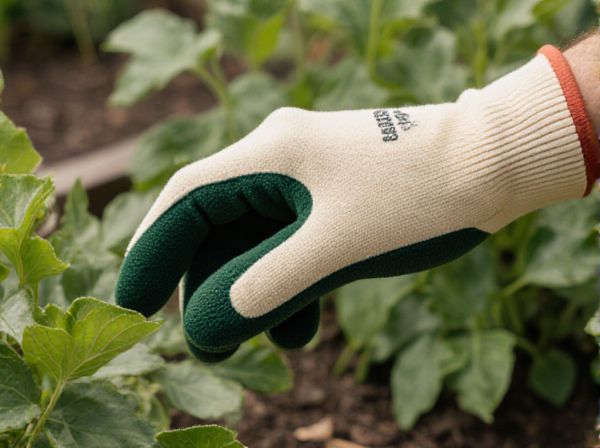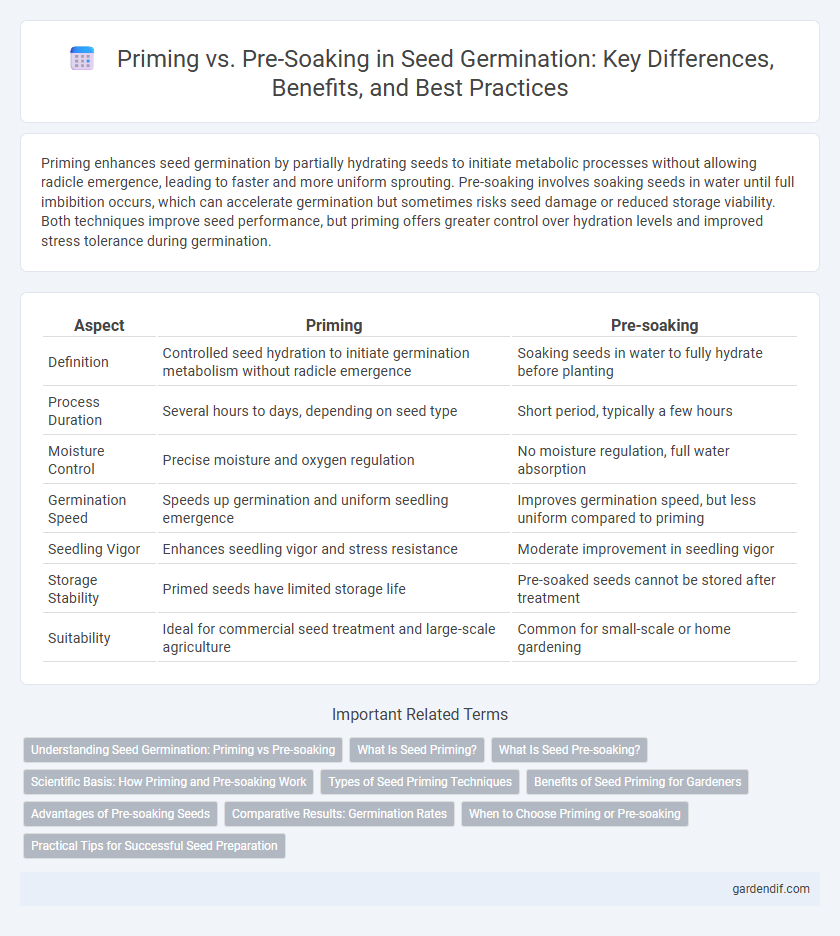
Priming vs Pre-soaking Illustration
Priming enhances seed germination by partially hydrating seeds to initiate metabolic processes without allowing radicle emergence, leading to faster and more uniform sprouting. Pre-soaking involves soaking seeds in water until full imbibition occurs, which can accelerate germination but sometimes risks seed damage or reduced storage viability. Both techniques improve seed performance, but priming offers greater control over hydration levels and improved stress tolerance during germination.
Table of Comparison
| Aspect | Priming | Pre-soaking |
|---|---|---|
| Definition | Controlled seed hydration to initiate germination metabolism without radicle emergence | Soaking seeds in water to fully hydrate before planting |
| Process Duration | Several hours to days, depending on seed type | Short period, typically a few hours |
| Moisture Control | Precise moisture and oxygen regulation | No moisture regulation, full water absorption |
| Germination Speed | Speeds up germination and uniform seedling emergence | Improves germination speed, but less uniform compared to priming |
| Seedling Vigor | Enhances seedling vigor and stress resistance | Moderate improvement in seedling vigor |
| Storage Stability | Primed seeds have limited storage life | Pre-soaked seeds cannot be stored after treatment |
| Suitability | Ideal for commercial seed treatment and large-scale agriculture | Common for small-scale or home gardening |
Understanding Seed Germination: Priming vs Pre-soaking
Seed priming enhances germination by partially hydrating seeds to activate metabolic processes without radicle emergence, improving uniformity and speed of germination. Pre-soaking involves soaking seeds in water to fully hydrate them before planting, which can lead to faster germination but may increase susceptibility to pathogens and reduce seed storage life. Priming offers controlled moisture uptake, promoting stress tolerance and improved seedling vigor compared to the simpler pre-soaking method.
What Is Seed Priming?
Seed priming is a pre-germination treatment that involves controlled hydration of seeds to initiate metabolic processes without radicle emergence. This technique enhances germination speed, uniformity, and seedling vigor by activating enzymatic activity and improving cellular repair mechanisms. Unlike pre-soaking, seed priming carefully regulates moisture uptake and drying to optimize seed physiological state for better field performance.
What Is Seed Pre-soaking?
Seed pre-soaking involves soaking seeds in water for a specific period before planting to enhance germination rates and uniformity. This method helps soften the seed coat, accelerates water absorption, and activates metabolic processes essential for germination. Unlike priming, which often uses controlled moisture and additives, pre-soaking relies solely on water immersion to prepare seeds for faster and more synchronized emergence.
Scientific Basis: How Priming and Pre-soaking Work
Priming enhances germination by partially hydrating seeds to initiate metabolic processes without allowing radicle emergence, improving uniformity and speed. Pre-soaking involves soaking seeds in water to fully absorb moisture before planting, triggering enzyme activation but risking oxygen depletion if prolonged. Scientific studies highlight that priming modulates osmotic potential and activates repair mechanisms, whereas pre-soaking primarily focuses on hydration without controlled metabolic regulation.
Types of Seed Priming Techniques
Seed priming techniques include hydropriming, osmopriming, and biopriming, each enhancing germination by regulating water uptake or applying beneficial agents. Hydropriming involves soaking seeds in water for a controlled duration, while osmopriming uses osmotic solutions like polyethylene glycol to improve stress tolerance. Biopriming employs beneficial microorganisms to enhance seed vigor and disease resistance during germination.
Benefits of Seed Priming for Gardeners
Seed priming enhances germination speed and uniformity by partially hydrating seeds under controlled conditions, which activates metabolic processes without radicle emergence. This method improves seedling vigor, leading to stronger plants and higher yields compared to pre-soaking, which can cause oxygen deprivation and seed damage. Gardeners benefit from increased tolerance to environmental stress and more predictable crop establishment through seed priming techniques.
Advantages of Pre-soaking Seeds
Pre-soaking seeds accelerates the germination process by ensuring uniform moisture absorption, which enhances seed viability and vigor. This method reduces the time required for seeds to break dormancy compared to priming, leading to faster and more consistent sprouting rates. Pre-soaking also simplifies seed preparation, requiring less specialized equipment, making it accessible for various agricultural practices.
Comparative Results: Germination Rates
Priming seeds enhances germination rates by initiating metabolic processes without full imbibition, leading to faster and more uniform seedling emergence compared to pre-soaking, which fully hydrates seeds but may cause uneven germination and increased risk of seed decay. Studies reveal primed seeds often exhibit germination rates exceeding 90%, while pre-soaked seeds typically show variable rates between 70% and 85%, depending on species and environmental conditions. Optimized priming protocols improve seed vigor and stress tolerance, making it a preferred technique over pre-soaking for commercial agriculture and horticulture applications.
When to Choose Priming or Pre-soaking
Choose priming when uniform germination and faster seedling emergence are critical, as it allows controlled hydration without triggering full germination. Opt for pre-soaking when rapid water uptake is needed for quick seed activation in species with hard seed coats or under time constraints. Priming is ideal for improving stress tolerance, while pre-soaking suits immediate germination in favorable conditions.
Practical Tips for Successful Seed Preparation
Priming involves soaking seeds in a controlled solution and then drying them to enhance enzyme activity and uniform germination, while pre-soaking simply means soaking seeds in water for a short period before planting. To optimize results, use priming for seeds with hard coats or those requiring faster emergence, and ensure pre-soaking is brief to avoid seed damage or fungal growth. Always dry primed seeds to their original moisture content for better storage and handle pre-soaked seeds promptly to maintain viability.
Priming vs Pre-soaking Infographic

 gardendif.com
gardendif.com